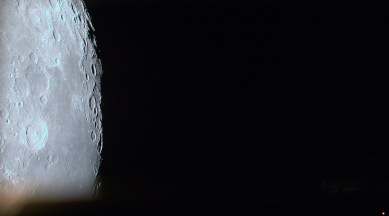Japan’s Hakuto, India’s Vikram & Israel’s Beresheet: Moon landers that never made it
Japan's Hakuto is not the only recent lunar mission that failed to achieve a soft landing on the Moon.

The many recent space exploration successes like the Artemis 1 mission and the launch of the James Webb Space Telescope may have had us forgetting an important thing–space is hard. But that immutable fact once again surfaced as Japan’s Hakuto spacecraft has probably crashed into the Moon.
“If space is hard, landing is harder. My heart goes out to the ispace team. I know from personal experience how awful this feels,” tweeted Laurie Leshin, director of NASA’s Jet Propulsion Laboratory, responding to the Hakuto crash.
And yes, Leshin only knows that feeling too well, since, according to Reuters, she worked on NASA’s Mars Polar Lander that crashed on the planet in 1999. But we do not even have to go as far as the red planet to understand how difficult space exploration really is.
So far, only three countries have managed to achieve a “soft landing” on the Moon–the United States, Russia, and China. India’s attempt to do the same with Chandrayaan-2 in 2019 ended in failure. An Israeli spacecraft that attempted to do the same earlier that year also failed to do so.
Here, we have put together a list of recent notable Moon missions that failed to achieve a soft landing on the Moon, including ispace’s Hakuto.
Japan’s Hakuto mission
If its Hakuto mission succeeded, Japan’s ispace would have made history as the first private company to pull off a soft landing on another world. But alas, that was not the case.
Ispace’s 2.3 metre-tall Hakuto-R lander took a slow, low-energy path to the Moon, travelling around 1.6 million kilometres from the planet before inserting itself into a lunar orbit. To put that into context, NASA’s Artemis 1 mission reached the Moon in about five days after take-off.
The lander was aiming for the Atlas crater in the northeastern section of the Moon’s near side. The Hakuto mission was also carrying the United Arab Emirates’ small Rashid Rover, which was meant to explore Earth’s lone natural satellite for about ten days.
According to ispace, it was able to confirm that the lander was in a vertical position as it carried out the final approach to the lunar surface. But shortly ahead of the scheduled touchdown, the company’s engineers noticed that the spacecraft’s fuel was quite low and a little after that, it began picking up speed and engineers lost contact with it.
Despite the failure of its first mission, ispace is continuing to plan for its upcoming Mission 2 and Mission 3, which are scheduled to happen in 2024 and 2025 respectively.
India’s Chandrayaan-2 mission
India also harboured dreams of landing a spacecraft on the Moon, and we almost did it when the Chandrayaan-2 mission attempted to land on the Moon on September 6, 2019. But those dreams were shattered just 13 minutes after the mission’s Vikram lander began its descent.
It was expected that right before touchdown, a few hundred kilometres above the lunar surface, the lander would have hovered above the surface, trying to ascertain whether it was a safe place to land.
But after starting its descent, Vikram fired four of its thrusters in the direction of its movement in an attempt to decelerate. It travelled nearly 585 kilometres in a parabolic path before losing contact with the ground station.
The mission’s Vikram lander and Pragyan rover were supposed to land on the Moon and carry out observations for 14 days but only the orbiter component of Chandrayaan-2 actually completed its objectives.
Israel’s Beresheet spacecraft
In 2019, before the Chandrayaan-2 mission, Israel attempted to land the small and cheaply-built Beresheet lander on the Moon. The lander, which was about the size of a small washing machine, lost communication with ground control during its final descent and crashed onto the lunar surface on April 11, 2019.
Opher Doron, then VP at Israel Aerospace Industries, told AP at the time that the spacecraft’s engine turned off shortly before landing. This left the Bersheet in pieces, scattered at the landing site. “It is by far the smallest, cheapest spacecraft ever to get to the moon,” he said to AP.
Interestingly, the Beresheet mission took a longer route than Hakuto. It travelled a total of 6.5 million kilometres in an effort to conserve fuel and reduce cost. It had launched atop a SpaceX rocket launched from Florida in February 2019.